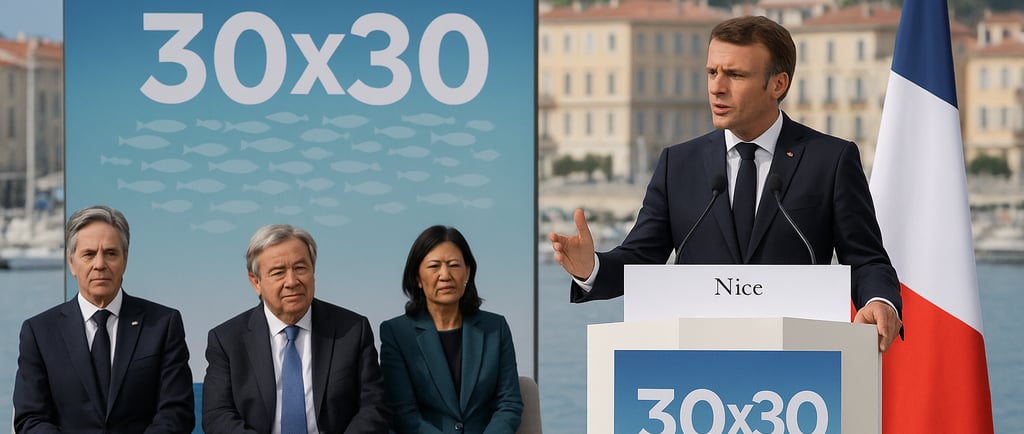French marine protected areas: historic progress or smoke and mirrors?
EUROPE
Killian Ravon
7/2/20255 min read


The turquoise waves die on the pebbles at dawn. In Nice's Carras harbor, an amateur fisherman casts his line before the city awakes from its slumber. Further down, a diver splits the azure and comes back up, mask on his face: a discreet witness to a vibrant ecosystem under the trails of aircraft and the distant hum of the wastewater treatment plant. Between concrete and nature, this postcard sums up the challenge: to absorb the urban flow while preserving this marine jewel. Shortly after the Third United Nations Conference on the Oceans (UNOC-3) in Nice, France reaffirmed its goal of increasing the proportion of its waters classified as marine protected areas to 30% by 2030. The world's second-largest maritime domain, France already boasts 565 MPAs covering 32.5% of its marine area...
FRANCE IN THE 30X30 ERA
On paper, France is off to a good start. By 2022, French protected sites (national parks, reserves, Natura 2000, etc.) totalled 3.4 million km², covering 32.5% of the country's maritime territory. This effort places France among the world leaders in terms of volume covered. The government, co-organizer of UNOC-3, is highlighting this asset: achieving the 30×30 objective “through the creation of new marine protected areas” is one of Nice's key objectives. At the One Ocean Summit in Brest (2022), followed by the UN summit in Montreal (2022), France and the EU made a commitment to protect 30% of the world's ocean surface, including a significant proportion in its national domain.
Yet these figures conceal many subtleties. France's MPAs are unevenly distributed. Metropolitan waters are minimal (3.6% of the total), and are “spread out” with small and numerous MPAs, covering 45.3% of this area. Conversely, the coverage of the outermost regions (96.4% of the domain) is highly heterogeneous: excellent in the French West Indies, Mayotte, New Caledonia or the Southern Territories (with giant extensions such as the Coral Sea), very poor in Reunion Island, French Guiana or Saint-Pierre-et-Miquelon. This mosaic reveals the inversion of priorities: vast “protected” areas (such as in Polynesia) are often far from human pressure, while the Atlantic, Channel and Mediterranean coasts are poorly covered. At the Nice summit, Emmanuel Macron praised the French inventory, but experts insist that the real issue is not the total surface area, but the actual intensity of protection.
PROTECTED AREAS : A SEA OF HOLES
In reality, the majority of French “protected areas” remain open to exploitation. According to a recent CNRS survey, only 1.6% of French waters benefit from full or strict protection (and barely 0.1% for metropolitan waters alone). In other words, most of the MPA “network” still allows fishing, including the most destructive. In fact, in over 98% of French MPAs, the use of bottom fishing gears (trawls, dredges, etc.) is still authorized. As Radio France points out, “most MPAs authorize regulated uses, including industrial fishing and bottom trawling”. This generalized rule is fraught with consequences: according to the NGO Oceana, in 2024 more than hundred trawlers accumulated more than 17,000 hours of fishing in just six French marine nature parks. Sanctuaries" on paper often serve as buffer zones for economic use, rather than as fully sanctuarized reserves.
The discrepancy can be seen in the figures: while France claims 32.5% “coverage”, independent analyses estimate that barely 3% of its waters are truly safe from extractive activities. Worse still, these rare protected pockets are overwhelmingly located in the remote areas of the Southern Territories. In the North Sea, Atlantic or Mediterranean, almost all catches are prohibited. In addition to the examples cited by the press, only a handful of French areas meet the high international standards of protection. In the Gulf of Lion or the Corsican Channel, scientists compare these areas to mere “tourist parks” where trawlers slice shamelessly through seagrass beds. The French model of “à la carte” MPAs has led to it being said that this is more a case of “a sword in the water” than a real turning point.
NICE 2025 : THE 4% ANNOUNCEMENT UNVEILED
In Nice, communication was all about exaggerated figures. Just before the opening of the UNOC, Emmanuel Macron gave one interview after another, making grandiloquent statements. The ministerial press kit of June 8 claimed that the proportion of metropolitan waters totally closed to trawling would jump from 0.1% to 4% by the end of 2026, thanks to the creation of new “strong” MPAs. This sleight of hand was quickly exposed. By analyzing the official maps, the NGO BLOOM revealed the trick: these famous 4% are hardly any new areas, but the same areas where trawling has already been prohibited since... 2017 by a European regulation. In other words, the government has announced as “progress” the labeling of areas already sanctuarized for other reasons, with no real ecological gain.
In this context, the “big announcement” turns into a publicity stunt. As BLOOM's Swann Bommier vigorously puts it, this “shameful announcement” is designed to “make a gigantic publicity operation” for the conference. Claire Nouvian, founder of BLOOM, speaks bluntly of an “ecological sham”: we can't claim to be protecting the ocean while leaving the activities of the industrial fishing lobbies untouched. Activists at note that during UNOC-3, we saw more gadgets (participative frescoes, decorations, anti-pollution flagship, etc.) than binding measures. Communication aside, France's policy on MPAs remains timid: in March 2023, the government even torpedoed a European plan proposing to ban trawling in MPAs, on the pretext of “protecting fishermen's jobs”. In short, the commitments made at Nice are considered by civil society to be manifestly inadequate.
PORT-CROS : A LIVING SANCTUARY
However, when the political will and regulations are strict, the results can be spectacular. The Port-Cros National Park (Var) is a palpable illustration of this. Created in 1963 and extended in 2012, it is Europe's oldest MPA. In this “zone under high protection”, fishing and boating are strictly controlled. The figures speak for themselves : the grouper population has grown from around 40 individuals before the park was created to almost 1,000 today, and the posidonia meadows - these “marine lungs” - are thriving in abundance. Biologist Sandrine Ruitton sums it up: it's a “biological safe”, where fish capital grows and spills over beyond the park's boundaries. Port-Cros is a virtuous model: the return of a dense and diverse fauna shows that real protection (strict zoning, monitoring of fishermen, surveillance) can make the ocean alive and resilient. This isolated success is proof that France's MPAs could live up to their promise, provided that we get away from the rhetoric and tighten up the framework.
FROM INK TO SEA : WHERE'S THE TURNING POINT ?
The Nice conference gave the illusion of a giant step forward for the ocean, but the balance sheet remains unfinished. France's promises look like a distant horizon: lots of figures, little concrete action where it counts. What remains to be done is to transform the smoke and mirrors into real change, reinforce fishing bans in MPAs, finance their management and bring together fishermen and scientists. Faced with the collapse of marine biodiversity, can we be satisfied with “marine protected areas” on paper? Only determined and verifiable action will put an end to what looks too much like “MPA-washing”. Let's hope the discussion continues: the question is no longer just how many MPAs, but how they really protect. Are we ready to demand that France move from media hype to effectiveness in the field? What happens next will determine whether France assumes its leadership role or simply rides the wave of greenwashing.
Killian Ravon, for SPECTIO
The opinions expressed are those of the authors and do not reflect the position of Think Tank Spectio.
